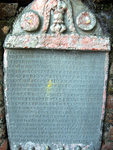A stone inscription at the Vajravārāhī temple in Sankhu memorializing the establishment of a rest-house and a guṭhī by Vīra Bhāro (NS 967)
ID: PD_0001_0002
Edited and
translated by Bal Gopal Shrestha and Ramhari Timalsina
in collaboration with
Manik Bajracharya
Created: 2017-04-23;
Last modified: 2024-01-09
For the metadata of the document, click here
The accompanying edition, translation/synopsis and/or commentary are available under the terms of the Creative Commons Attribution-ShareAlike 4.0 International License
Abstract
This inscription, attached to the wall of the dharmaśālā built on the premises of the Vajravārāhī temple in Sankhu, records the establishment of the dharmaśālā and a guṭhī for supporting it by Vīra Bhāro and his family during the reign of King Rājendra Vikrama Śāha.Diplomatic edition
[]
1श्रीवज्रवाराहीदेव्यैनमः ।। ।।मुनिरसग्रहयुक्तेरम्येनेपालसंवते2माघेकृष्णेनागतिथ्यांसूर्योर्क्षेभृगुजेदिने ।।श्रीवज्रवाराहीसुप्रस
3न्नफलाप्तये ।।शंखरापुरदेशस्यवीरनामेनभक्तिना ।। भार्य्यापुत्रादि
4तर्पणधर्मसालासुनिर्मिता ।। तद्दिनेविधिवत्सर्वंप्रतिस्थाकारिताशुभा
5 ।। अद्यब्रह्मणोद्वितीयप्रहरार्द्धेश्वेतवाराहकल्पेवैवश्वत्मन्वन्तरेअ
6ष्टाविंशतिक्रमसेकलियुगेकरेप्रथमपादेजाम्वुद्वीपेभरथखण्डे
7भारतवर्षेआर्य्यावर्त्तदेशेहैमवद्दक्षिणपार्श्वेनेपारमण्डलेवाशुषि
8क्षेत्रेश्रीपशुपतिसन्निधानेवागमत्यायांपूर्वकोणेमनमत्यायांपश्चिम
9कोणेअनेगदेवतालयसंनिधानेशंखरापुरनगरस्यअग्नेकोनेश्री
10वज्रवाराहीदेवीस्ठानेइहैवपुण्यभूमौ ।। ।। अथपरंदेशभाखासम्व
11त९६७माघकृष्णपंचमिहस्तानक्षत्रेशुक्रवारथ्वकुनुश्री३राजराजे
12न्द्रविक्रमसाहदेवस्यविजयराज्येसंखरापुरनगरेइपातोलसा
13गाननिछेयामानवत्यात्रवीरभारोभार्य्यादयालक्ष्मिज्येष्ठपुत्रअन्तना
14रांभार्य्यामयजुलक्ष्मिद्वितीयपुत्रद्रवषद्वीरभार्य्याराणिवतिपौत्रपुन
15रत्नथुतिसयाधर्मचित्तजुयाओथुगुधर्मसालादयेकाओप्रतिस्था
16यानाजुलोथ्वधर्मसालायातजिओनितकिवुरो३पेसकिफं६श्री३व
17ज्रवाराहीप्रीतिनदुन्तातयाओलसानंदयदस्यांसेंल्होकिफं१५वाकि
18नंवर्षपतिवाहानदुगुम्ह१दयकाओश्री३देवीसाहासंपूजायानाओ
19गुथिजनपनिसनभक्षाभोजनयायेमालश्रावनमहिनासवर्षपतिं
20तुंपुयमालथ्वतेयागुथिजनअन्तनारां,वषद्वीर,मुनिनारां,धन्तसिं,सिं
21नरसिं,थुतिसेनदयदस्यांखंण्डितमयासेंनिस्तरपेमालजुलशुभ
Translation
[1r]
(In Sanskrit:) Hail to the glorious goddess Vajravārāhī. On Friday, the eighth of the dark fortnight of Māgha when the sun was in the constellation Ṛkṣa, in Nepal Era 967, a devotee named Vīra, a resident of the town of Śaṅkharāpura full of devotion, in order to obtain glorious Vajravārāhī’s gracious fruits established a dharmaśālā as refreshment for his wife, sons and others. On that day, the consecration was carried out, all rituals being performed according to the rules. Auspiciousness.
Today [is] in the middle of the second prahara of Brahman, in the kalpa named Śvetavārāha, in the Manu period called Vaivaśvata, at the 28th stage of the Kali age, in the lunar mansion Hastā, in its first quarter; in Jāmbudvīpa, in the Bharata section of Bhāratavarṣa, in the Āryāvarta territory, to the south of the Himalayas, in Nepālamaṇḍala, in the Vāsuki region, in the vicinity of glorious Paśupati, to the east of the Vāgmati, to the west of the Manamati, at this auspicious place lying south-east of Śaṅkharāpura town, at the temple of the glorious goddess Vajravārāhī.
(From here onward in Newari:) On Friday, the fifth of the dark fortnight of Māgha in Nepāla Saṃvat 967 (1847 CE); on this day, in the territory of the thrice venerable king Rājendra Vikrama Sāha, in the town of Śaṅkharapura, residents of Sāgā Nani Che, Ipātola—Vīra Bhāro, his wife Dayālakṣmi, their eldest son Antanārāṃ and his wife Mayajulakṣmi, their second son Bakhad Vīra and his wife Rāṇīvati and their grandson Punaratna—having generated virtuous thoughts [and] having built this dharmaśālā, performed [the rituals for its] consecration. For this dharmaśālā, we have donated with pleasure to the threefold glorious Vajravārāhī 3 ropanīs of land and 6 sakiphaṃs.1 From now on, one should annually mould [the goddess], together with [her] vehicle (vāhana), using 15 pāthīs (phaṃ) of seṃlhoki2 rice (vāki), and jointly worship the threefold glorious goddess, and then the members of the guṭhī should hold a feast. Annually, in the month of Śrāvana, one should clean the well. The guṭhī members Antanārāṃ, Bakhad Vīra, Muninārāṃ, Dhantasiṃ and Siṃnarasiṃ should carry out the task annually without interruption. Auspiciousness.
Commentary
This inscription is attached to a wall of the rest-house built on the premises of Sankhu’s Vajravārāhī temple. This temple is known by the inhabitants of Sankhu as Vāṃdādyo (‘rain-beaten goddess’). She is considered as one of the eight mother goddesses located on the outer rim of Sankhu. The first half of the inscription is written in Sanskrit, while the second half is in the Newari language. An analysis of this inscription in Newari language is published in Shrestha 2013: 74-76.

